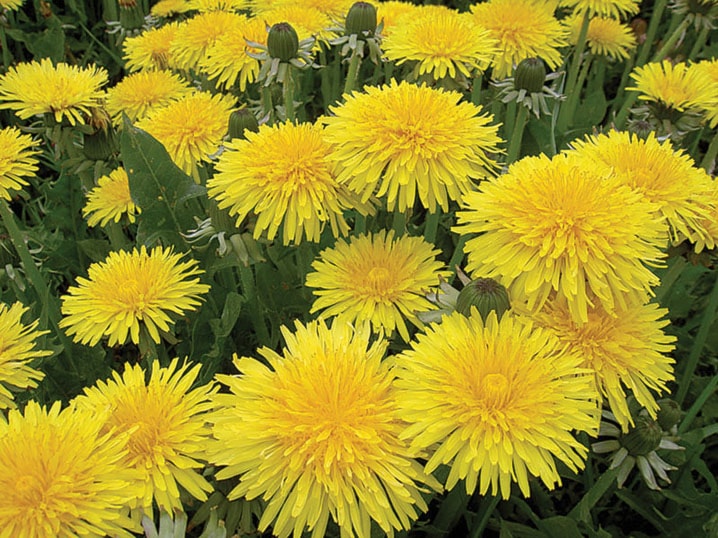Last month, I presented a workshop called Putting Weeds to Work at the Calgary Horticultural Fair.
I arrived early to take in the show. It was a great show, with everything from creative plant containers, to wildflowers native to Alberta Parklands, outrageous lilies and delicate miniature roses hardy to Zone 3.
My prize find was a shopping bag with the outrageous statement sprawled across its front, Dandelions Never Killed Anyone. The bag also sports the Canadian Cancer Society logo. The man handing out the bags explained the City of Calgary sponsored the booth to the safe disposal of cosmetic pesticides. A couple, scratching their heads in dismay, asked the city worker, “What are you supposed to do with the dandelions?”
There are many ways to use dandelions, besides pouring poison on them. I am not the only one who considers the use of pesticides to kill dandelions harmful to human life. The Ontario College of Physicians advises, “avoid exposure to all pesticides whenever and wherever possible.”
The Canadian Nurses Association, Canadian Liver Association, The Learning Disabilities Association of Canada and The Allergy-Asthma Information Association all support a moratorium on the use of cosmetic pesticides.
So what to do with dandelions? Here’s some suggestions:
1. Facial masks made with dandelion flowers are a Russian beauty secret. Pluck five dandelion flowers and toss into the blender. Then add a quarter cup of plain yogurt and one tablespoon of honey. Blend well. Gently smooth the paste over your face. Let the mask do its work for about 20 minutes, rinse off with warm water. Your skin will be as bright and sunny as day in May.
2. The dandelion’s roots and leaves are a perfect spring tonic being one herbal medicine’s best and gentlest liver cleanses. The leaves are high in minerals and vitamins.
Three dandelion leaves have 1½ times the daily recommended dose for vitamin A. Dig up eight juicy dandelion roots, do not detach their leaves. Pluck off any unappetizing leaves. Wash in cool, running water. Chop both the root and leaves. Put them in a pot and cover with cool water. Bring the water to a quiet simmer for 40 minutes. Strain and enjoy a half cup twice a day for three days. Store the tea in the fridge.
Just a note: The early the leaves are harvested the better they taste.
3. A traditional remedy for getting rid of nasty warts is the latex found in the dandelion’s stem. Slice open the stem, there will be a milky substance oozing out of the cut. This white liquid kills warts. Rub the stem over the wart, and then apply some duct tape to keep the stem in place. Do this every night for three weeks. There will be no scarring.
4. For the adventurous cook, dandelion pesto makes for good conversation at the dinner table.
1 cup of chopped dandelion leaves
1 cup of olive oil
4 cloves of garlic peeled
6 tablespoons of roasted pine nuts (walnuts are interesting substitute)
1½ teaspoons of sea salt
¼ cup of grated parmesan cheese
Whirl all the ingredients together in the blender until they form a paste. Pour the paste into a jar and store in the fridge. Serve it on pasta; replace the mayonnaise with it in potato salad, or use it as a veggie dip.
5. Then there is dandelion flower jelly. It tastes like honey! Pick 10 cups of dandelion blossoms. Pluck the petals off the stems, use only petals in the jelly.
Pour boiling water over the petals, just cover them, and let the flowers and water mingle over night. Strain in the morning. The water is now a very strong, dandelion flower tea. Check the recipe on the back of the box containing the pectin, and add more water to the tea if needed. Follow the recipe on the back of the box of pectin. Have fun making labels for the dandelion jelly jars.
When using dandelions for food or medicine there is a very important consideration: The flowers, leaves and roots need to be picked from a pesticide free area.
When living in a city or county that does not have a cosmetic pesticide ban in place, this is almost impossible. Think about this, urbanites spray four times the amount of herbicides per acre of home lawn as the farmer uses per acre of farmland. That is extraordinary, as dandelions have never killed anyone.
Herbs for Life is written by Abrah Arneson, a local clinical herbalist. It is intended for information purposes only. Readers with a specific medical problem should consult a doctor. For more information, visit www.abraherbalist.ca. Arneson can be reached at abrah@shaw.ca
